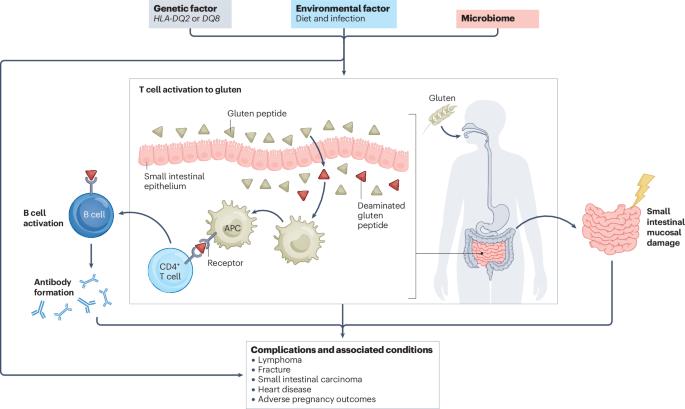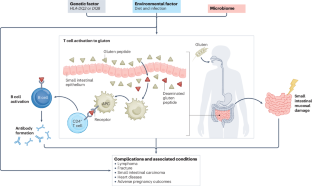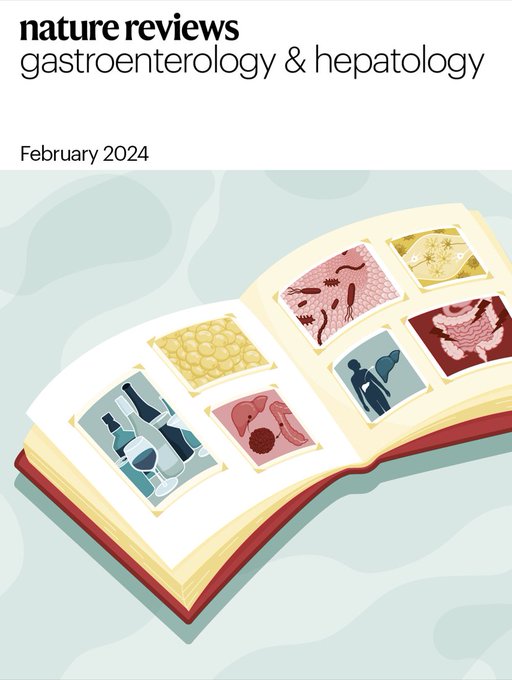乳糜泻:并发症和合并症
IF 51
1区 医学
Q1 GASTROENTEROLOGY & HEPATOLOGY
引用次数: 0
摘要
乳糜泻是一种自身免疫性疾病,其特征是接触麸质后小肠绒毛萎缩和炎症。它的全球患病率约为1%。虽然无麸质饮食是一种有效的治疗方法,但这种饮食在实践中存在困难,并且经常无意中暴露于麸质。此外,乳糜泻有多种潜在的并发症和合并症,可能与吸收不良和/或慢性免疫激活有关。总的来说,与一般人群相比,患有乳糜泻的个体死亡率增加,强调了这种常见疾病的严重性。与乳糜泻相关的合并症和并发症包括生长不良、生殖并发症、肾脏和肝脏疾病、呼吸系统疾病(如肺炎)和感染(包括败血症)。此外,乳糜泻还与其他自身免疫性疾病、精神疾病以及某些癌症有关。数据表明,无麸质饮食的粘膜愈合可能会防止一些,但不是全部的这些并发症。在这篇综述中,我们提出了乳糜泻相关疾病的绝对和相对风险。我们讨论了潜在的机制,无麸质饮食和粘膜愈合的作用,以及对乳糜泻的随访和非饮食治疗的影响。本文章由计算机程序翻译,如有差异,请以英文原文为准。


Coeliac disease: complications and comorbidities
Coeliac disease is an autoimmune disease characterized by small intestinal villus atrophy and inflammation upon exposure to gluten. It has a global prevalence of approximately 1%. Although the gluten-free diet can be an effective treatment, this diet is burdensome with practical difficulties and frequent inadvertent gluten exposure. Moreover, there are a variety of potential complications and comorbidities of coeliac disease that might be related to malabsorption and/or chronic immune activation. Overall, individuals with coeliac disease have increased mortality compared with the general population, underscoring the severity of this common disease. Comorbidities and complications that have been associated with coeliac disease include poor growth, reproductive complications, kidney and liver diseases, respiratory disease (such as pneumonia) and infections (including sepsis). Furthermore, coeliac disease has been linked to other autoimmune disease and psychiatric disease, as well as certain cancers. Data suggest that mucosal healing on a gluten-free diet might protect against some, but not all, of these complications. In this Review, we present absolute and relative risks of coeliac-associated disorders. We discuss underlying mechanisms, the role of the gluten-free diet and mucosal healing, as well as implications for follow-up and non-dietary treatment of coeliac disease. In this Review, Ludvigsson and colleagues describe the epidemiological associations between coeliac disease and a variety of complications and comorbidities, and discuss the pathophysiology underlying these complications as well as implications for follow-up and treatment.
求助全文
通过发布文献求助,成功后即可免费获取论文全文。
去求助
来源期刊
CiteScore
52.30
自引率
0.60%
发文量
147
审稿时长
6-12 weeks
期刊介绍:
Nature Reviews Gastroenterology & Hepatology aims to serve as the leading resource for Reviews and commentaries within the scientific and medical communities it caters to. The journal strives to maintain authority, accessibility, and clarity in its published articles, which are complemented by easily understandable figures, tables, and other display items. Dedicated to providing exceptional service to authors, referees, and readers, the editorial team works diligently to maximize the usefulness and impact of each publication.
The journal encompasses a wide range of content types, including Research Highlights, News & Views, Comments, Reviews, Perspectives, and Consensus Statements, all pertinent to gastroenterologists and hepatologists. With its broad scope, Nature Reviews Gastroenterology & Hepatology ensures that its articles reach a diverse audience, aiming for the widest possible dissemination of valuable information.
Nature Reviews Gastroenterology & Hepatology is part of the Nature Reviews portfolio of journals.

 求助内容:
求助内容: 应助结果提醒方式:
应助结果提醒方式:


